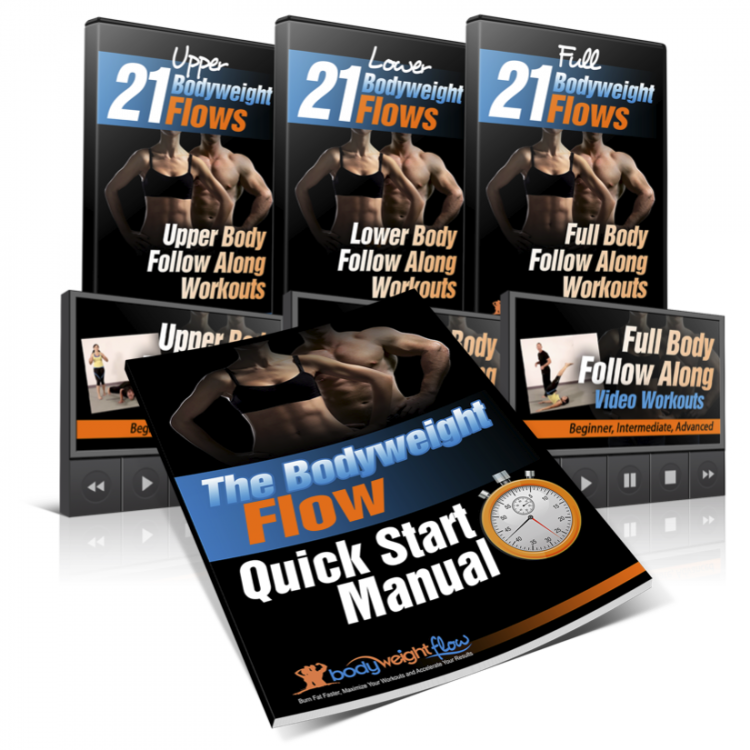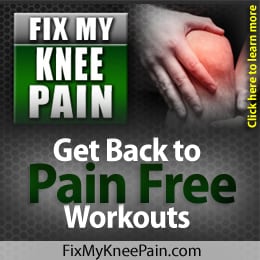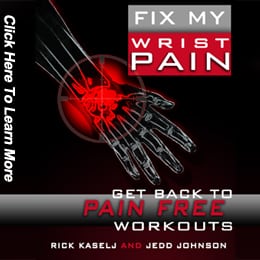Warm Up versus Bodyweight Flow
I hope you enjoyed the Fantastic 4 Bodyweight Workout from yesterday.
Today I have the second part of the interview with Sylvia Favela & Tyler Bramlett. (You can check out part 1 over here.)
In this part Sylvia & Tyler share with you:
- difference between a calisthenic warm up and a bodyweight flow
- example of a beginner bodyweight flow
- example of a crazy advanced bodyweight flow
Enjoy.
~ rick
=======================
Rick Kaselj: Okay so some people might be thinking well this just sounds like a fancy way of saying “warm up.”
How would the body weight flows differ from just a typical calisthenic warm up that a lot of people end up doing?
Sylvia Favela: Do you mind if I jump in on this one?
Tyler Bramlett: Go ahead.
Sylvia Favela: It differs in a sense that when you are learning to flow from one to the next to the other, when you are learning to contract the muscles and using proper form, you are firing all the muscles at once that literally you are already in that workout stage where it is just not like “Oh, let us just warm up the muscles.” You are already firing so many muscles that it doesn’t take a whole lot of movement to already get your body flowing and moving to where every single muscle for example is your core.
As you move your core should already be firing in like in a couple of seconds to do this. So when you are doing that as opposed to warm-up stretches these are more intense. It’s going to get your body already ready and the faster you learn how to do these and you flow with them, you will be able to get even deeper into your work. So I don’t know, Tyler maybe you want to add something on top of that.
Tyler Bramlett: Sure. I will touch it briefly. Warm-up is a great word. People talk about warm-ups, pretty workout routines. What we wanted to do with our flows is it’s not even necessary to call them warm ups or a part of it. If you look into them like the scientific literature, this stuff sticks. If you do a pre-workout routine, it is still relevant on your body getting better results during workouts up to 24 hours afterwards. You still get better results for up to 24 hours.
I am the kind of a person where it doesn’t really matter to me when you learn how to flow. You can wake up in the morning and do one of our 2 to 3 minute flows right out of bed. Just like kind of wake up your nervous system, increase your range of motion, throw some limbs around, and everything.
You can do them before your workouts for that specific reason as a warm-up. You could do them after your workouts for some movement practice, some recovery, some leaning up or loosening up the muscles that you just used. And then you could also do them between your exercises, something that I would say would be really beneficial for people who are very into strength training.
People who are doing power lifting, people who are doing Olympic lifting, maybe cross fit style work outs, doing a flow in between their higher intensity components of their workouts in order to loosen up their body. We found again through the research that it technically reduces lactic acid during the workout.
It’s just moving the fluids around and then there is that neurological benefit that science has not really been able to quantify that you would add on top of this as well. That is the hard part Rick because we wanted really to have a lot of good scientific proofs for this and we do have some research studies to back up what we are talking about, but there aren’t a lot of people who are able to quantify the things like the neurological benefits. And the way I think of the nerves is if I put a hose on top of a giant dirt hill, when I first turn that on, all these different pathways are going down.
Think of it like our brain when we are young. But as we move in one particular fashion over and over again as the hose keeps running it’s going to groove in just in few different streams. So these people are locked into their movement patterns because they’ve never experienced something else.
You might have seen this in power lifters. Nothing is wrong with the power lifters, they train amazing, these guys are some of the strongest guys in the world but they are also sacrificing a lot of their health because of this.
Their body doesn’t move in the way that it probably should be anymore because they are doing some heavy lifting up on some basic compound lifts. If somebody like a huge body builder or power lifter would add in some flow work between their sets and the cool thing is that these guys rest for 5-10 minutes anyways so they might as well do a 2-3 minute flow, just to do something else with your time, I think they would get better overall results. If nothing less, they would probably reduce the chance of getting injured. Okay so maybe that kind of adds on to it.
Rick Kaselj: Okay. Looking at where these flows end up going, I mean they can be placed in prior to the workout, in between sets. Is there any other place where these flow workouts can be put in?
Sylvia Favela: Well, I would say anytime, anywhere. Really, it is where you can do it. Lunch break, and if you have to get up and move around or if you are sitting at your desk and if you can do a few of these, I mean that would actually help. There is no specific time when you do it, it’s just a matter of doing them. That is really the goal.
Tyler Bramlett: The reality is this Rick, if somebody does one flow 2-3 minutes per day maybe five days a week, just give me that one flow per day five days a week, they are going to see a significant change in the way they move.
And the way they are going to see is this is they are going to for five days and they are going to be like holy cow, everything starts to feel a little bit different. After thirty days, they are going to go stand up from their chair or their bench like Sylvia’s talking about and they are going to rotate from the hips rather than from the knee joint or from the ankle joint and they are going to say how did I learn how to do that.
They are going to be playing with their kids on the ground and they are going to roll over into a standing position from a plank, and they are going to be like weird, I did not think about that but I am moving more efficiently, I am feeling better, I am feeling stronger.
So yes, they are designed to boost the results you get from your workouts but you are likely going to see these things improving in your daily life as well. And so to answer your question, it’s not about when you do it, it’s whether or not you are willing to give me two minutes to consistently do it.
It’s like diet. You know diet can make so many people get better results instantly but how many people do you know that are consistent with it? Tons of people are like “My exercise routine is not working” or maybe it’s just their diet routine, right?
It’s really about consistency. I keep repeating that to people over and over again. As much as I love the 21 day this and 15 day that, I want people trying out the body weight flow two minutes a day for thirty days and they will see enough results out of that and they will probably want to do it for the rest of their lives.
Rick Kaselj: Okay, so let us go through an example. I am an absolute beginner. I am just starting exercise, maybe Sylvie you can give us an example of a total beginner flow or where you would start off with someone with a beginner flow.
Tyler Bramlett: Good Luck.
Sylvia Favela: It would be a series of three movements. One would be working through or rolling through your back, lying on your back, rolling through your back, and then slightly going over into a side position and maybe where you are kind of coming up into a side plank where you are kneeling. This is the kind of the road where you go and back again. More power curls where you will lift your hips and then over on to the other side.
So you are kind of warming up the spine, warming up the sides, lateral movements to kind of help your body. Really it is more so being aware of what your body is doing and just knowing, “Okay if I move my hips up this way and if I rotate here laterally through the oblique, okay I will feel that as well.”
Something like that is kind of a beginner movement. Just knowing how to really move side to side because if you really watch kids or young kids or babies, they could lay on their back, right away they roll over on to their sides. So it’s something really basic and simple like that is probably where I would start somebody off something very basic. So Tyler would you add anything or another example or something.
Rick Kaselj: No, Tyler will get the craziest one. You know I have been exercising for a long time. Okay so what is this flow thing, you know. Give me a challenging flow.
Tyler Bramlett: A challenging flow! You know the hardest part about things like flows is that you describe them and it doesn’t really do them much justice. So the first thing I will say is me and Sylvia, let us hook Rick up with a free flow for all your readers Rick so that they can just watch it. (You can check it out here.) It is so much easier to just watch it and got through the instruction and just like watch your computer and go and just do a two minute flow to see how powerful it can be. So we will hook you up with one. You can check that out.
I will give you an example of a more advanced flow, I took a move called the Tornado squat and we strung them together in three different levels and then we added in a component of single leg stability and core stability, kind of a bear position as well.
Okay I am just going to show you. Let us do it this way. So I hold like my lower body, I am going to rotate down; I am going to drop my knee. So I am rotating down and I tend the legs open, pull back up and come back around. I didn’t add any of the advanced component to that but teaching people how to go from a standing position to a seated position and back to the standing position with proper joint alignment by using that rotational stability and mobility, right. And that is it just and you know that was a terrible example obviously and people are not going to pick up on it.
Rick Kaselj: No, that was good.
Tyler Bramlett: Yes, okay. So just to give you guys an example, what we are doing there is rotating from a squat into a lunge, dropping the knee back even further, opening the hips up coming down, coming in through a butterfly position and then rotating up the exact opposite way and you can go from right to left. Literally if you do that back and forth three times and then go to your squat work out or go to your cycling workout or go to your runs or something like that you are going to feel five times looser. You are going to feel like you have a better connection with your muscles.
Like I said the best part is that you go to a park and you are holding on to your baby and you cannot figure how to get down to your butt because you want to sit down on the grass, all you got to do is rotate down and “oh look, I am in a seated position and I feel great.” That is just one example of a more advanced and a little bit more complicated routine.
Rick Kaselj: I don’t have any more questions but is there a question that I have not asked or something that you would like to leave the readers or viewers with?
Tyler Bramlett: Yeah, I can kind of jump in on a couple of things real quick.
Rick Kaselj: Of course Tyler.
Tyler Bramlett: Of course, I could talk all day about this. You guys got all day I am going to tell you all the problems and things that are wrong with the fitness industry. I think the reason why we really wanted people to know about movement and we are trying to educate people about movement and this is not like some crazy advanced program, we are not asking you to do crazy back bridges and hand stands and things like that. I have got other programs for that.
This is to get anybody, literally anybody realizing that movement is the foundation of exercise, right. And so we have already done the person one person two thing but another great example is just to think about one person just moves well and the other person just doesn’t move well and we take both of these people and we put them on the same training routine.
Well the person who does not move well is not going to get good results. They are going to feel bad about themselves because they are watching the person who moves well getting great results following the same routine as them and they are also increasing the risk of getting injured and pretty exponentially, right. They don’t know.
Here is the problem. This guy who moves well naturally doesn’t know why he is getting results. He just happens to move well and some people just move well, right, and I am jealous of those people because I was not born moving well. I had to learn how to move well through many injuries. And the person who is not getting the results that they want and they are watching that other person getting great results, that person is frustrated because they think it is them. They think it is their laziness, they think it is their routine but it is not. It is their ability to effectively move their body that makes that workout program powerful.
So we are not telling people to follow a suspension training program or a body weight program or gymnastic or kettle bells or barbells whatever. We don’t really care what workout routine you are following. We are trying to optimize your movements so whatever you do you are safer and you get better results from it, that is our goal with this program. And I just want to cut through the confusion because I feel like people who are frustrated with their exercise they don’t know the reason why they are not getting results, it might be because they suck at moving.
Rick Kaselj: Yeah. It’s true. Alright Sylvia, you have any last points?
Sylvia Favela: The last point that I would say is that in addition to what Tyler was saying that some people just don’t know how to move well. And also for those people who have never moved and have never done any exercise that their doctor is all of a sudden saying “hey, guess what you need to start exercising,” and again it’s like frustration “Oh God, what do I do?” and then they don’t see any results. This is something that those people can possibly use to start moving.
Start to learn how to move and go from one movement to the other. So for beginners, anybody, just really everybody needs this and again it could be the top of the line athletes. Those people are already professional, weight lifters, moms, dads, anybody so this is just a well-rounded flow. It’s just for anybody, from a beginner all the way to advanced.
Rick Kaselj: Awesome! So thank you very much Tyler and Sylvia.
Tyler Bramlett: Our pleasure!
Sylvia Favela: Thank you
Rick Kaselj: Thank you everyone from ExercisesForInjuries.com. If you want to check out Tyler and Sylvia’s bodyweight flow program, you can here.
Rick Kaselj, MS
.




